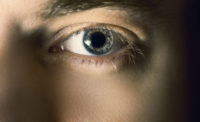Most surveys and studies indicate that the majority of people in the United States with vision loss are adults who are not totally blind; instead, they have what is referred to as low vision. You may have heard the terms "partial sight" or "partial blindness" or even "poor vision" also used to describe low vision. Those descriptions are no longer in general use, however.
Here is one definition of low vision, related to visual acuity:
Low vision is a condition caused by eye disease, in which visual acuity is 20/70 or poorer in the better-seeing eye and cannot be corrected or improved with regular eyeglasses. (Scheiman, Scheiman, and Whittaker)
Visual acuity is a number that indicates the sharpness or clarity of vision. A visual acuity measurement of 20/70 means that a person with 20/70 vision who is 20 feet from an eye chart sees what a person with unimpaired (or 20/20) vision can see from 70 feet away.
20/70 can best be understood by examining a standard eye testing chart that you may have used in your own doctor's office during an eye examination.
In the United States, the Snellen Eye Chart (pictured above) is a test that ophthalmologists and optometrists use to measure a person's distance visual acuity. It contains rows of letters, numbers, or symbols printed in standardized graded sizes.
Your eye doctor will ask you to read or identify each line or row at a fixed distance (usually 20 feet), although a 10-foot testing distance is also used.
If you can read line 8 (D E F P O T E C) from 20 feet away while wearing your regular glasses or contact lenses, the doctor records your vision (or visual acuity) as 20/20 with best correction.
If the smallest print you can read is line 3 (T O Z) from 20 feet away while wearing your regular glasses or contact lenses, the doctor records your vision (or visual acuity) as 20/70 with best correction.
An actual Snellen Eye Chart is much larger than the one depicted here; therefore, it's not recommended that you use this chart to test your own (or a friend's or family member's) visual acuity.
Not all eye care professionals agree with an exclusively numerical (or visual acuity) description of low vision. Here's another — more functional — definition of low vision:
Low vision is uncorrectable vision loss that interferes with daily activities. It is better defined in terms of function, rather than [numerical] test results. (Massof and Lidoff)
In other words, low vision is "not enough vision to do whatever it is you need to do," which can vary from person to person.
Most eye care professionals prefer to use the term "low vision" to describe permanently reduced vision that cannot be corrected with regular glasses, contact lenses, medicine, or surgery.
If you have low vision, it is necessary to have a different kind of eye examination that uses different and more detailed tests to determine what you can and cannot see.
Source: Maureen A. Duffy, Making Life More Livable: Simple Adaptations for Living at Home After Vision Loss (New York, NY: AFB Press, American Foundation for the Blind, 2015), p. 11. © 2015 by American Foundation for the Blind. All Rights Reserved.



